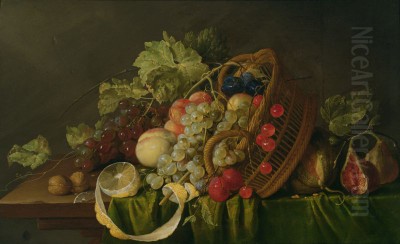
The 17th century witnessed an unprecedented flourishing of art in the Low Countries, a period often referred to as the Dutch Golden Age and the era of Flemish Baroque. Within this vibrant artistic landscape, specialization became common, with painters dedicating their careers to landscapes, portraits, genre scenes, or still life. Among the most accomplished practitioners of still life painting was Cornelis de Heem (1631-1695), an artist whose work masterfully blended the opulent traditions of Flemish Baroque with the meticulous detail characteristic of the Dutch Golden Age. Born into an artistic dynasty, he carved out his own identity while building upon a formidable family legacy, leaving behind a body of work celebrated for its technical brilliance, vibrant colour, and rich symbolism.
Early Life and Artistic Formation in a Painter's Household
Cornelis de Heem was baptised in Leiden, a prominent city in the Dutch Republic, on April 8, 1631. His artistic destiny seemed preordained, as he was the son of Jan Davidszoon de Heem (1606-1684), arguably the most celebrated and influential still life painter of his generation. The elder De Heem's reputation was immense, his works sought after by collectors across Europe for their exquisite detail, complex compositions, and luxurious subject matter. The family did not remain in Leiden for long; they relocated to Antwerp in the Southern Netherlands (Flanders) likely around 1635-1636.
Growing up in Antwerp, Cornelis received his primary artistic training directly from his father. This apprenticeship within the family workshop was crucial. He would have learned the fundamentals of drawing, the preparation of pigments and panels, and the intricate techniques required to render textures convincingly – the gleam of metal, the softness of velvet, the translucence of grapes, the fuzz on a peach. Jan Davidsz. de Heem's studio was a hub of activity, and Cornelis absorbed not only technical skills but also the compositional strategies and thematic concerns that defined his father's oeuvre. The influence of Jan Davidsz. is undeniable, particularly in Cornelis's early works, which often echo his father's arrangements and choice of objects.
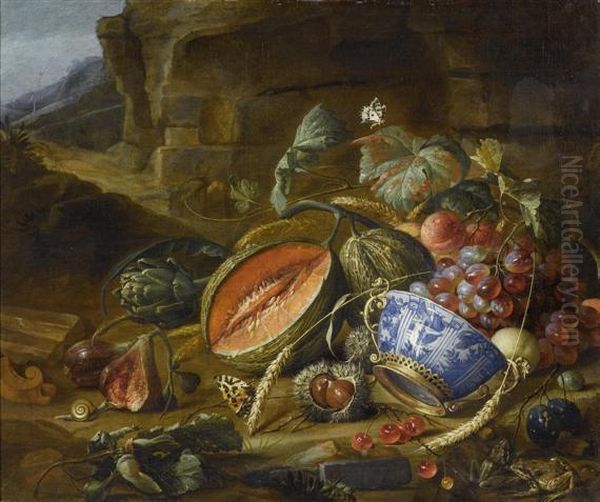
The De Heem family itself was a veritable artistic powerhouse. Cornelis's brother, Jan Jansz. de Heem, also became a painter, as did his nephew, Jan Janszoon de Heem the Younger. Later, Cornelis's own son, David Corneliszoon de Heem (c. 1663 – after 1718), would continue the family tradition. This environment fostered a deep immersion in the craft and business of painting, but it also presented the challenge for Cornelis to distinguish himself from his highly successful relatives.
The Antwerp Context and Professional Recognition
Antwerp, despite experiencing political and economic shifts after its separation from the Northern Netherlands, remained a major artistic centre in the 17th century. The legacy of Peter Paul Rubens still loomed large, and the city boasted numerous talented painters. It was within this competitive yet stimulating environment that Cornelis de Heem established his professional career. A significant milestone was his acceptance into the prestigious Guild of Saint Luke of Antwerp, the official organisation for painters, sculptors, and other artisans. Records suggest he became a master in the Guild around 1660 or 1661, formally acknowledging his status as an independent artist.
Membership in the Guild was essential for legally selling artwork and taking on apprentices. Shortly after, in 1661, he was also elected as a member of the "Oude Handboog" guild, a civic organisation, further indicating his integration into Antwerp's professional and social fabric. His presence in Antwerp was not continuous; records indicate periods spent working in Utrecht and possibly The Hague, reflecting the mobility common among artists of the era seeking patronage or varied artistic influences. However, Antwerp remained his primary base for much of his mature career.
In Antwerp, Cornelis would have been aware of the work of other prominent still life painters beyond his own family. Daniel Seghers (1590-1661), a Jesuit painter famous for his flower cartouches often surrounding religious scenes, was a significant figure whose meticulous floral depictions may have offered inspiration. Abraham Mignon (1640-1679), though German-born, worked in Utrecht and was known for his detailed forest floor still lifes and flower pieces, sharing a similar dedication to naturalistic detail. The broader Antwerp scene included masters like Jacob Jordaens and David Teniers the Younger, whose robust genre scenes and different specialisations contrasted with, yet formed part of, the city's rich artistic tapestry.
Artistic Style: Inheritance and Innovation
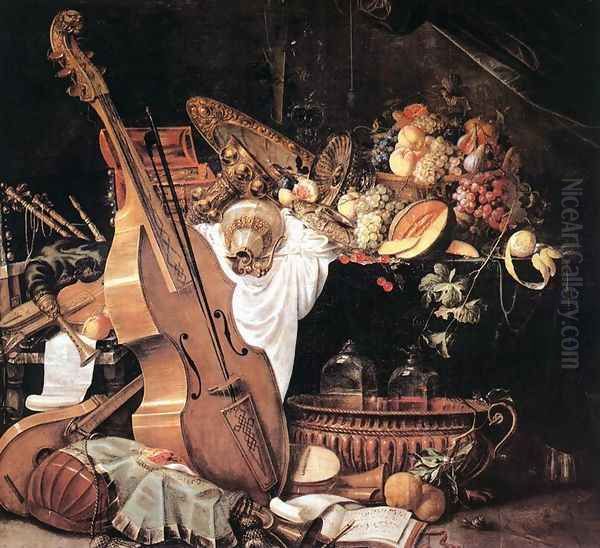
Cornelis de Heem's artistic style is fundamentally rooted in the still life tradition perfected by his father, yet it evolved distinct characteristics over his career. He specialised primarily in fruit and flower pieces, often arranged in elaborate compositions that conveyed a sense of abundance and luxury. His technique was marked by meticulous attention to detail, rendering surfaces and textures with remarkable verisimilitude. Light plays a crucial role in his paintings, highlighting the ripeness of fruit, the delicate structure of petals, and the reflective qualities of glass and metal.
While inheriting his father's penchant for complex arrangements and rich detail, Cornelis developed a distinct colour palette. Art historians consistently note his preference for strong, vibrant blues, which often serve as a dominant or contrasting element in his compositions. This inclination towards cooler tones, particularly blues and greens, marks a subtle departure from the warmer, often more golden or reddish hues favoured by Jan Davidsz. de Heem in many of his works.
Furthermore, while Jan Davidsz. produced numerous large-scale, highly elaborate pronkstillevens (ostentatious still lifes), Cornelis often worked on a somewhat smaller, more intimate scale. His compositions, though detailed, can sometimes feel less densely packed than his father's most ambitious works. This shift might reflect personal preference, market demands, or a conscious effort to differentiate his style. His brushwork, while precise, could occasionally exhibit a slightly looser, more fluid quality compared to the almost microscopic finish of his father's prime pieces.
His work embodies a fascinating synthesis of regional styles. The richness, dynamism, and often opulent subject matter connect him to the Flemish Baroque tradition exemplified by artists like Frans Snyders (though Snyders focused more on game and market scenes). Simultaneously, the precise rendering, careful observation of light, and underlying sense of order align him with the Dutch Golden Age tradition seen in the works of Northern Netherlandish painters. Cornelis navigated these influences, creating a style that was both inherited and uniquely his own.
Themes and Symbolism in De Heem's Still Lifes
Like many still life paintings of the period, Cornelis de Heem's works often operate on multiple levels. Beyond the sheer visual delight of the depicted objects, his paintings frequently carry symbolic meanings, reflecting contemporary cultural, religious, and moral concerns. The objects chosen were rarely arbitrary.
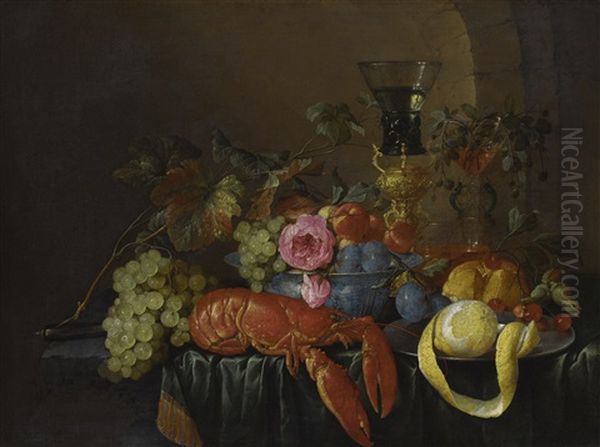
Fruit and flowers, his most common subjects, were laden with symbolism. Grapes, frequently depicted with luminous transparency, could allude to the Eucharist (the blood of Christ) and themes of life and resurrection. Peaches might symbolise truth or salvation, while cherries could represent heavenly reward. Flowers, beautiful but ephemeral, often served as vanitas symbols, reminding the viewer of the fleeting nature of life, beauty, and earthly pleasures. A wilting petal or an insect boring into a fruit subtly reinforced this message of transience.
Cornelis also painted pronkstillevens, showcasing luxurious items like imported fruits (lemons, oranges), expensive glassware (like the Venetian-style façon de Venise glasses or German Römers), silver platters, and sometimes shellfish like lobsters or oysters. These objects symbolised wealth, trade, and the prosperity enjoyed by the merchant classes in the Low Countries. However, they could also carry a moralising undertone, warning against excessive indulgence and worldly attachment, consistent with the prevailing Calvinist ethos in the North and Catholic sensibilities in the South.
Some of his works explicitly engage with the vanitas theme, incorporating objects like skulls, hourglasses, extinguished candles, or musical instruments. These elements served as direct reminders of mortality and the vanity of human pursuits. A work titled Vanitas Still Life with Musical Instruments clearly falls into this category, using objects associated with fleeting pleasures (music) alongside symbols of time and death.
Religious themes could also be central, as seen in works like Eucharist in Fruit Wreath. This composition type, popularised by artists like Daniel Seghers, features a central religious image or symbol (in this case, the Host and Chalice representing the Eucharist) surrounded by an exquisitely painted garland of fruit and flowers. These paintings combined devotional imagery with a celebration of nature's beauty, understood as God's creation. The symbolic meanings of the individual fruits and flowers (grapes, wheat for the Eucharist) would further enrich the theological message.
Key Works and Analysis
Cornelis de Heem's oeuvre is represented in major museums worldwide. Examining some specific works reveals the nuances of his style and thematic concerns:
_Still Life with Vegetables and Fruit before a Garden Balustrade_ (1658; Städel Museum, Frankfurt): This relatively early work clearly shows the influence of his father. It features a lavish display of fruits and vegetables spilling from baskets and arranged on a stone ledge, set against an architectural background with a view into a garden. The composition is abundant, the colours rich, and the textures meticulously rendered. It speaks to the ideals of cultivated nature and aristocratic or wealthy bourgeois life, celebrating earthly bounty.
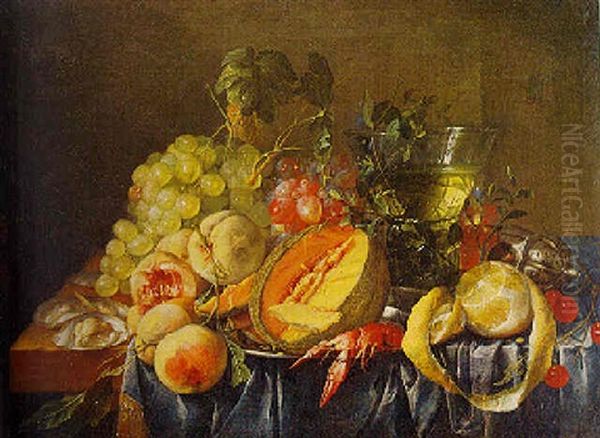
_Fruit Still Life_ (1695; Mauritshuis, The Hague): Painted in the year of his death, this work (measuring 65 x 50 cm) exemplifies his mature style. It likely features a characteristic arrangement of fruits – perhaps grapes, peaches, cherries, and a peeled lemon – rendered with his typical attention to light and texture. The presence of his signature blue tones might be expected. Such late works demonstrate his continued dedication to the genre throughout his life.
_Still Life: A Banqueting Scene_ (Metropolitan Museum of Art, New York): This title suggests a pronkstilleven, depicting the remnants of a luxurious meal. Such scenes often included expensive foods like pies, ham, oysters, or lobsters, alongside fine tableware, glassware, and perhaps casually draped, rich fabrics. These works showcased the painter's skill in rendering diverse textures and reflected the patron's wealth and status, while potentially carrying underlying vanitas connotations about the fleeting nature of such pleasures.
_Still Life with Ham, Lobster and Fruit_ (Museum Boijmans Van Beuningen, Rotterdam): Similar to the Banqueting Scene, this work focuses on luxurious foodstuffs. The depiction of a large ham, a bright red cooked lobster, and various fruits would have allowed Cornelis to display his virtuosity in capturing different colours, shapes, and textures – the rough skin of a melon, the segmented shell of the lobster, the glistening surface of the ham.
_Vanitas Still Life with Musical Instruments_ (Location varies/private collections): Works with this theme typically juxtapose objects of worldly pleasure and intellectual pursuit (musical instruments, books, globes) with symbols of death and the passage of time (skulls, snuffed candles, hourglasses). De Heem's treatment would likely feature his characteristic detailed rendering and careful composition to convey the moral message effectively.
_Eucharist in Fruit Wreath_ (Location varies/private collections): These devotional paintings required immense skill in rendering the delicate forms and colours of numerous flowers and fruits, arranged harmoniously around a central sacred image. They combined botanical accuracy with religious piety, a specialty particularly strong in Antwerp.
Through these examples, we see Cornelis de Heem navigating the established conventions of still life while infusing them with his personal stylistic preferences, particularly his distinctive use of colour and light.
The De Heem Dynasty: Collaboration and Attribution
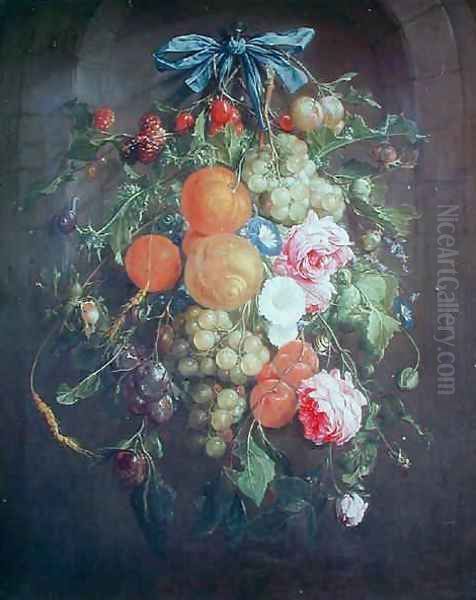
The fact that Cornelis worked alongside his father, brother, nephew, and later his own son creates complexities for art historians, particularly regarding attribution. Family workshops often involved collaboration, with different members potentially contributing to a single painting. An apprentice or son might paint the background elements or less critical objects, while the master focused on the highlights. Signatures could also be complex; sometimes works produced in the workshop were signed by the head (Jan Davidsz. in his prime), even with significant contributions from others.
While Cornelis developed his own style, the similarities, especially in earlier periods or when closely collaborating, can make definitive attribution challenging for unsigned works or those bearing a generic "De Heem" signature. Distinguishing Cornelis's hand from that of his father Jan Davidsz., his brother Jan Jansz., or his son David Corneliszoon requires careful stylistic analysis, focusing on characteristic brushwork, colour preferences (like Cornelis's blues), compositional habits, and recurring motifs. This "De Heem problem" highlights the collaborative nature of art production in the 17th century but also underscores the need for connoisseurship in studying the family's output. Despite these challenges, Cornelis's individual contribution is recognised as significant and distinct within the family's collective achievement.
Influences and Contemporaries: Situating Cornelis de Heem
Cornelis de Heem's artistic world was shaped by direct influences and the broader context of his contemporaries. His father, Jan Davidsz. de Heem, was undoubtedly the primary influence, providing his initial training and stylistic foundation. The Antwerp milieu brought him into contact with the legacy of Daniel Seghers and the work of other Flemish specialists. The influence of Abraham Mignon, active in Utrecht where Cornelis also worked, is noted, particularly in the detailed rendering of natural elements.
Beyond these direct connections, Cornelis worked during a period rich with still life talent across the Low Countries. In the Dutch Republic, artists like Willem Kalf (1619-1693) created stunning pronkstillevens known for their dramatic lighting and depiction of precious objects, offering a point of comparison for opulent displays. Masters of the more restrained "monochrome banquet" pieces, like Pieter Claesz. (c. 1597-1660) and Willem Claesz. Heda (1594-1680), represented a different, more sober Dutch aesthetic, highlighting the diversity within the genre.
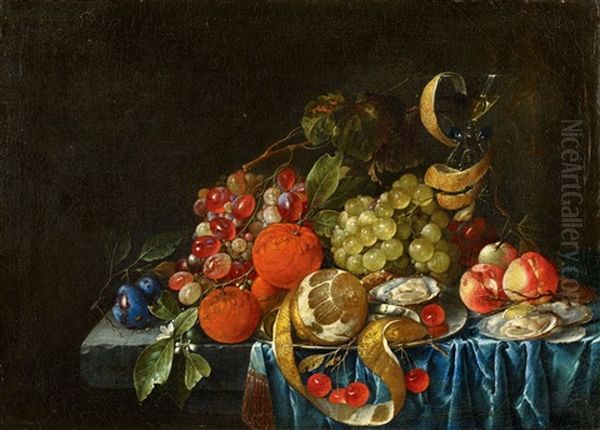
Flower painting, a sub-genre Cornelis excelled in, saw brilliant female practitioners like Rachel Ruysch (1664-1750) and Maria van Oosterwijck (1630-1693), whose works were highly sought after and demonstrate the high level of specialization and skill achieved in depicting floral arrangements. In Flanders, besides Seghers, artists like Frans Snyders (1579-1657) and Jan Fyt (1611-1661) excelled in large-scale still lifes often incorporating dead game and animals, representing a more robust Baroque energy compared to Cornelis's typically more delicate arrangements. Earlier Flemish pioneers like Clara Peeters (c. 1587–after 1657) had already laid groundwork for detailed still life painting in the Southern Netherlands.
Mentioning the towering figures of the era, Rembrandt van Rijn (1606-1669) and Johannes Vermeer (1632-1675), helps contextualise the sheer artistic brilliance of the period. While their primary focus was different (portraiture, history painting, genre scenes), their mastery of light, texture, and composition reflects the high standards and innovative spirit that characterised the entire artistic environment in which Cornelis de Heem operated.
Legacy and Art Historical Reception
During his lifetime and shortly after, Cornelis de Heem enjoyed considerable recognition. His works were collected, and his skill was acknowledged within the artistic community. His influence extended beyond his immediate circle; his ability to combine meticulous detail with harmonious colour compositions resonated with later artists. A fascinating testament to his enduring appeal is the fact that the French modern master Henri Matisse (1869-1954) studied and copied a still life by De Heem (likely Jan Davidsz., though sources sometimes mention Cornelis in this context, reflecting the family name recognition) in the Louvre, using it as a basis for his own explorations of colour and form.
However, like many artists from the period, Cornelis's fame perhaps became somewhat overshadowed by that of his father, Jan Davidsz. de Heem, whose reputation remained consistently high. Art historical assessments have sometimes positioned Cornelis as a talented follower rather than a groundbreaking innovator in his own right. Some critics might point to a perceived lack of deep emotional content, seeing his work as primarily focused on decorative beauty and technical skill – a criticism often levelled at highly refined still life painting. The attribution difficulties within the De Heem family may also have complicated the clear assessment of his individual contribution.
Nevertheless, modern scholarship recognises Cornelis de Heem as a highly accomplished artist with a distinct artistic personality. His mastery of technique, his sophisticated use of colour (especially his signature blues), and his ability to create visually stunning and symbolically rich compositions secure his place as a significant figure in 17th-century still life painting. His works continue to be admired for their beauty, craftsmanship, and insight into the visual culture of the Dutch Golden Age and Flemish Baroque. His paintings serve as important examples of the cross-fertilisation between the artistic traditions of the Northern and Southern Netherlands.
Market Presence and Collections
Cornelis de Heem's paintings remain sought after on the art market, appearing periodically at major auction houses like Sotheby's and Christie's, as well as regional auctioneers. Auction records, such as the sale of a Fruit Still Life at Sotheby's Amsterdam in 2003 for €85,400, or other sales in London and elsewhere, indicate a consistent collector interest. Prices vary depending on the size, quality, condition, provenance, and subject matter of the work.
His importance is further confirmed by the presence of his works in the permanent collections of numerous prestigious museums across the globe. Besides the aforementioned Mauritshuis (The Hague), Städel Museum (Frankfurt), Metropolitan Museum of Art (New York), and Museum Boijmans Van Beuningen (Rotterdam), his paintings can be found in institutions such as the Kunsthistorisches Museum in Vienna, the Musée Fabre in Montpellier, the Rijksmuseum in Amsterdam, and many others. This widespread institutional representation ensures that his art remains accessible for study and appreciation by the public and scholars alike. The survival of his works in these collections, often meticulously preserved, allows for continued admiration of his technical skill and artistic vision.
Conclusion: An Enduring Radiance
Cornelis de Heem stands as a testament to the depth and richness of still life painting during the 17th century. Born into the shadow of a famous father, he successfully forged his own artistic identity, marked by a distinctive colour sense and a consistent dedication to the meticulous rendering of the natural world and luxurious objects. His work elegantly bridges the artistic sensibilities of the Dutch Republic and Flanders, combining detailed realism with Baroque dynamism and opulence.
Though sometimes facing challenges of attribution within the prolific De Heem dynasty and perhaps lacking the revolutionary impact of the era's absolute giants, Cornelis's contribution remains significant. He mastered the complex vocabulary of still life, imbuing his canvases with visual beauty, technical prowess, and layers of symbolic meaning that reflected the values and anxieties of his time. From lush arrangements of fruit and flowers to sobering vanitas compositions, his paintings offer a luminous window onto the material culture and intellectual currents of the Golden Age. His works, preserved in museums and collections worldwide, continue to captivate viewers with their enduring radiance and exquisite craftsmanship, securing Cornelis de Heem's place as a respected master of his chosen genre.